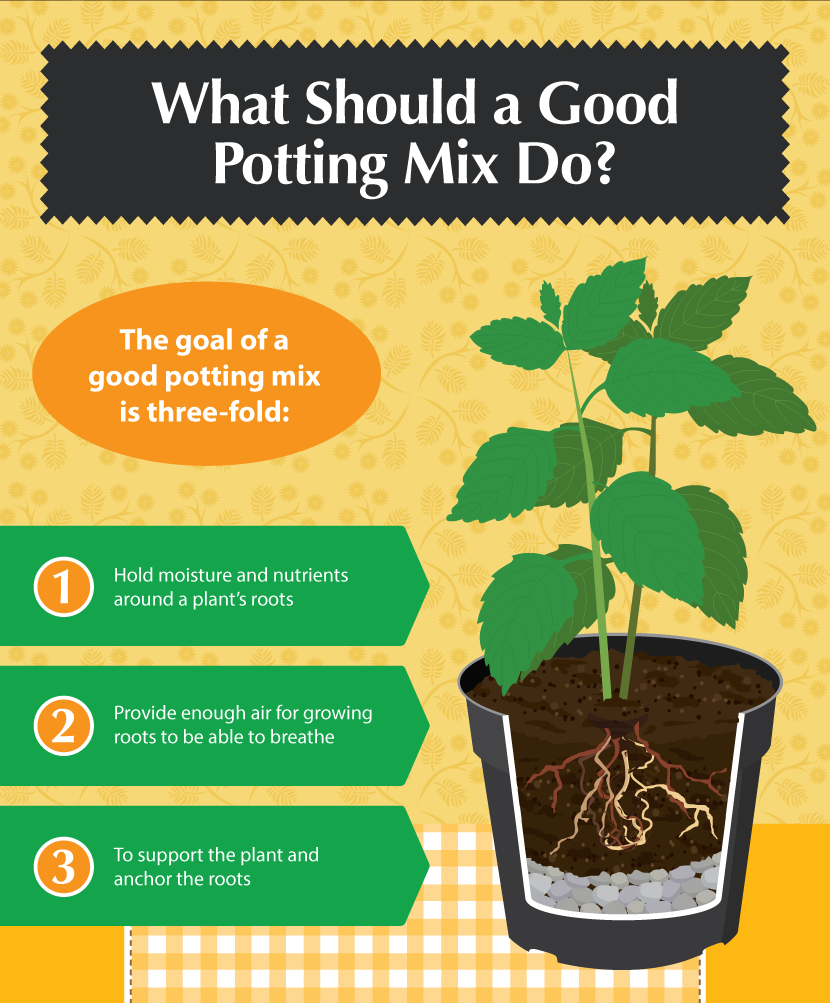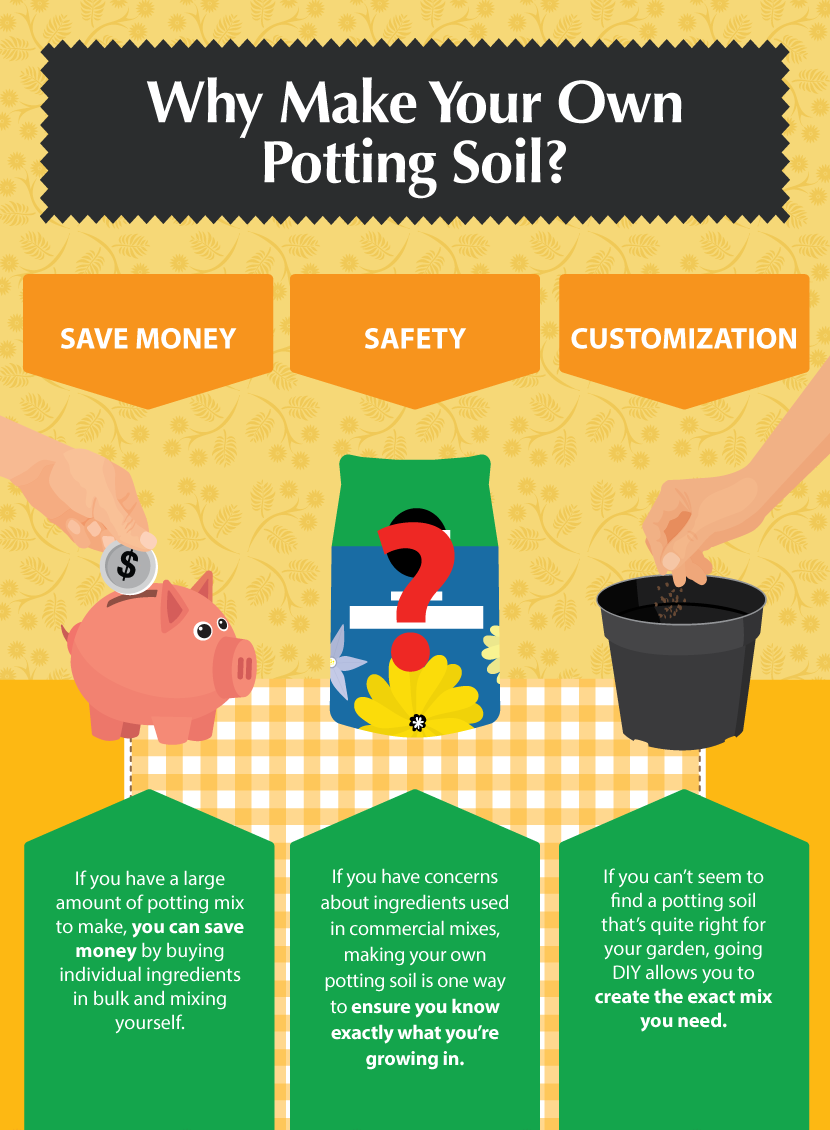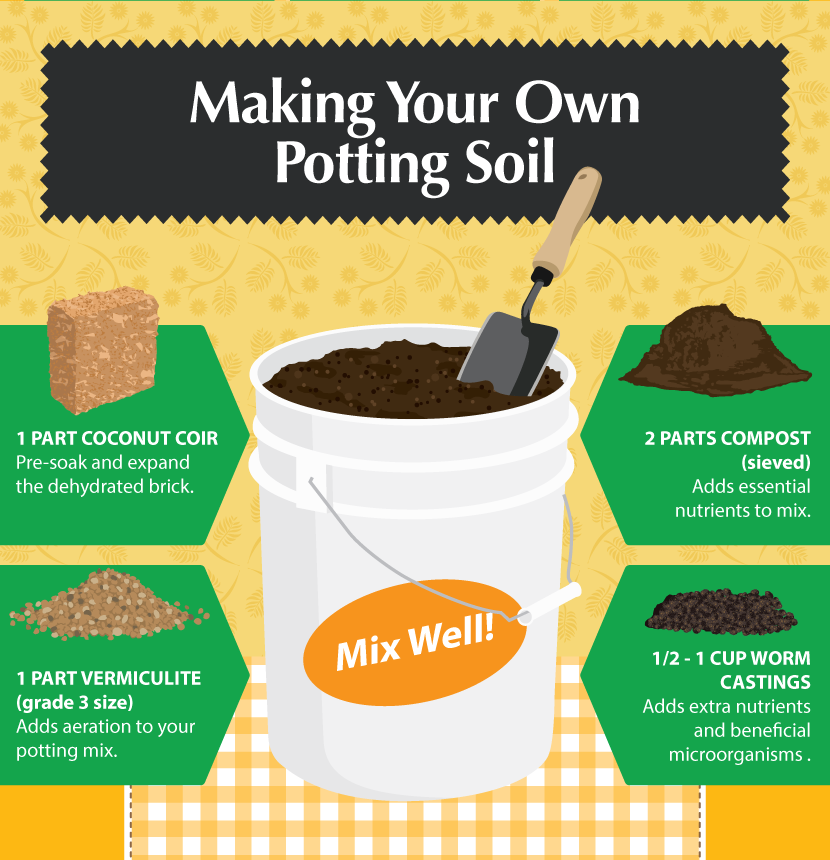DIY Potting Mixes
A Recipe for the Perfect Garden
One of the biggest mistakes new gardeners make is choosing the wrong potting soil.
Because soil is so crucial to a plant’s growth, it’s no surprise that making a mistake here can be devastating.
It doesn’t help that figuring out what type of potting soil is best can be a confusing process.
With all of the commercial options available, it’s hard to know what ingredients are best or if they’re safe,
or if making your own potting soil is a better option.
First, we’ll take a look at what a good potting soil should do, then we’ll dive into the different types on the market as well as how to make your own.
By the end of this article, you’ll come out knowing exactly how to make your own soil.

Before getting into the specifics, let’s look at what functions potting soil serves.
Delivers Water and Nutrients to a Plant’s Roots
The main goal of a quality potting soil is to get the right amount of nutrients and water to a plant. To do so, two conditions must be satisfied:
- The soil must have enough organic matter and nutrients
- The soil must retain enough water to deliver to a plant’s roots
These conditions are fulfilled by adding compost to the mix and by making sure you have enough material in your mix that retains water (but not too much).
Provides Air And Space For Roots to Breathe And Grow
A good potting mix also ensures that there’s enough room in the mix for roots to breathe and grow.
A plant’s roots desperately need oxygen in order to function properly,
so potting mixes that retain too much water or are too compact can seriously affect the growth of a plant.
Supports The Growth of The Foliage Above The Soil
Finally, the best potting mixes have enough structure to be able to support a plant as it matures.
This means it needs to be deep enough so roots can grow and provide the support structure that the plant needs.
The soil also needs to be loose enough – but not too loose – to allow roots to penetrate new soil properly.
Now that we understand the goals of a good potting soil, let’s take a look at why you might want to make your own soil.

There are many reasons that gardeners prefer to make their own potting mixes, but the three major reasons are:
Saving Money
There are plenty of low-priced potting soils on the market, but they’re low-priced for a reason: they usually don’t contain the best ingredients.
While making your own potting mix is usually not as cheap as the cheapest potting soil,
you can make amazing mixes that are much better for your plants for only a bit more money than the cheapest stuff at the garden center.
Safety
Because some of these commercial potting soil companies are producing so much at huge scales,
the quality control is often lacking. It’s not uncommon to find undecomposed manure, bits of plastic, or other contaminants in commercial mixes.
For this reason, many gardeners prefer to make their own mixes so they know exactly what they’re growing their plants in.
Many are even willing to shell out more money to have that peace of mind.
Customization
Experienced and beginner gardeners alike often grow plants that require higher concentrations of certain nutrients.
Another common scenario is when a gardener is growing a plant that needs a different soil texture or density to thrive.
Commercial potting soil mixes are often “one size fits all” and may not be the best choice, depending on what you are trying to grow.
This is where making your own mix can mean the difference between nothing growing at all and a lush, vibrant garden full of life.

While there are countless recipes for DIY potting soil all over the Internet,
here’s one that tends to fit most beginner gardeners’ requirements:
- 1 part coconut coir (for water retention)
- 1 part vermiculite (for aeration and space)
- 2 parts compost (for nutrients)
- ½-1 cup worm castings (for additional nutrients and microorganisms)
It’s important to note that the word “part” here can be any measurement you want, depending on how much potting soil you need to mix.
For instance, you might use 10 cubic feet as your “part,” giving you:
- 10 cu. ft. coco coir
- 10 cu. ft. vermiculite
- 20 cu. ft. compost
- 1 cup worm castings
This is the beauty of making your own mix – you can scale it up or down, add extra ingredients, and modify as needed.
Coconut Coir
Coir is the popular choice these days instead of peat moss due to the sustainability issues that peat moss faces.
If you’re making the environmental choice, going with dehydrated coconut coir bricks instead of peat moss to add water retention to your potting mix is the right approach.
All you need to do is rehydrate the bricks by soaking them in water for a few minutes, then adding them to your mix.
Vermiculite
Despite not having much in the way of nutrients, vermiculite adds an important quality to your soil: aeration and fluffiness.
This allows a plant’s roots to access oxygen and breaks up the density of the soil, making it easier for roots to penetrate deeper into the mix.
Vermiculite can be expensive, so using builder’s sand is another good option here.
Compost
If you have your own compost pile, then by all means use homemade compost in your mix. If not, try to buy the highest-quality compost you can find at your local garden store.
It may cost a bit more, but good compost is the cornerstone of a quality potting mix. It’s what contains most of the nutrients that a plant depends on to grow properly.
Worm Castings
This is a bonus ingredient that you should consider adding in.
Worm castings are some of the best natural sources of organic matter that you’ll find anywhere.
If you have your own worm composting setup, just use the castings that come from it.
Otherwise, pick some up at a local garden store. You don’t need to add much – a little goes a long way.
To assemble the mix, all you need to do is add the ingredients to a wheelbarrow or tarp and mix well.
Be sure to wet the mix down before you add it to your pots and raised beds.
There you have it: a beginner’s guide to what potting mixes are and how to make your first batch of soil.
As a beginner gardener, improper soil is the most common mistake made, so be sure to take action on these tips to avoid making it yourself!
Embed the article on your site

